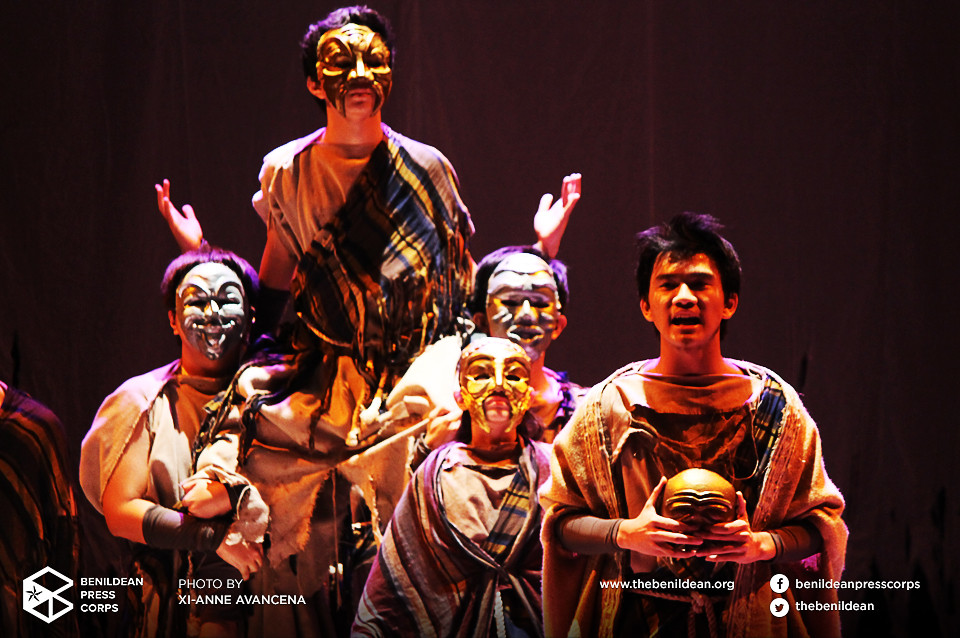The tale of Oedipus Rex, King of Thebes, who murdered his father and slept with his mother, is a story that is familiar to most—literary scholar or not. Dulaang Filipino, however, with complex albeit laborious Filipino dialogue, simple but effective costume and set designs, and an array of passionate, talented cast members, manages to attempt not just one, but all three of Sophocles’ Theban plays and give them a new, Filipino voice in an hour-and-a-half show held last August 13 to 15 at the School of Design and Arts (SDA) Theater that intricately weaves the pain of Oedipus, King Creon, and Antigone into a delicate but potent fabric of drama. And the loom: tragedy.
It is a dimly-lit set—succinct, but not sparse. Dangling from the scaffoldings are elegantly crafted set pieces that embellish the corners of the stage. This, and the tribal floor design on the stage are the only set pieces that Dulaang Filipino utilized to tell the tale of the legendary King Oedipus, who slew his father and made love to his mother; and his daughter, Antigone, bore from the incestuous relations they held.
Honesty, simplicity, and conviction in a new idea are the themes that can best be used to describe the play’s approach at the classic tragedies. In this production, the characters are given eloquent, Filipino dialogue that is crisp, vibrant, and at times— a little out of reach, that elucidates the director’s ideas in a sublime prose—supported by sign-language interpreters that deliver with as much tenacity as their speaking counterparts. “Creatively borrowing” from Onofre R. Pangsanghan’s production of Antigone of the same title, and Rolando S. Tinio’s lines for Oedipus from his translation “Haring Edipo”.
In this production, the characters are given eloquent, Filipino dialogue that is crisp, vibrant…
The pacing, despite occasionally feeling rushed white at the same time languid, relatively succeeds in retaining the audience’s attention with clever storytelling mechanisms and precise choreography. Performances by the actors proved to be formidable, and empowered with emotions that were convincing, believable, and true-to-form of the greek essence of drama, all the while maintaining a Filipino rapport in their style of delivery—if only they were as comprehensible as they were convicted. Impressive were the usage of props and set design, from the masks utilized by the cast, which seduced us with mystery all the while progressing the storyline while somehow leaving us questioning what they were used for in the first place.
However, the most distinct aspect of the production was not in the props, costumes, set, or choreography, though those were also notable. The production’s excellence and complexity lied in the unique perspective and method which the play was delivered to the audience. In Oedipus, the audience’s attention is drawn toward the profound ways that these characters are tied together in despair, and interlaced in deaths, dishonor, sin, betrayal, and the horror that plagued the Theban aristocracy.
Dulaang Filipino provides us with a minimalistic, charismatic, poignant, yet overdone approach towards Sophocles’ Theban tragedies.
The audience is taken briskly, through the backgrounds of Oedipus, King Creon, Antigone, and Jocasta and alternates through their respective dramas, beginning with the plague that sweeps the state of Thebes, all the way to the synchronized, morbid endings of Jocasta, Oedipus, and Antigone which, by their immediate unification, proved to somehow dilute the standalone plots of Oedipus and Antigone. This places the audience in a fresh viewpoint where they are compelled, educated and slightly confused through all the stories and characters of Sophocles’ great tragedies. In a sense, it is a high-brow lecture and reflection on the Theban plays told by a professor who likes to take three subjects on at once. Whether or not the audience is capable or willing to comprehend is another story.
Dulaang Filipino provides us with a minimalistic, charismatic, poignant, yet overdone approach towards Sophocles’ Theban tragedies. Its simple set and costume designs highlight the slightly-too-refined Filipino dialogue, and strong delivery by the actors. While the performers hobbled as they carry out the juggling of themes and stories in the plays, resulting in a climax which epitomizes all three tragedies in glorious finalities that resound after the curtains have closed.
Oedipus will be used to compete in the University of the Philippines 21st anniversary Theater Council “Juan Acts(s): A Student Call for Action through One-Act Filipino Plays”
—
UPDATE (9/15/14): The article has been updated with more details regarding the play’s background, adding proper credits as requested by Dulaang Filipino, and changing a minor detail removing the character Eurydice as previously reported.



